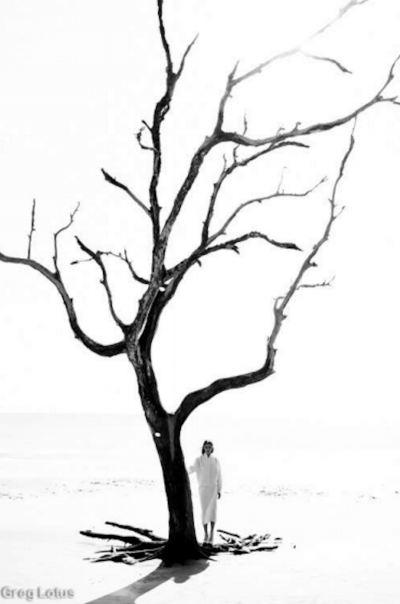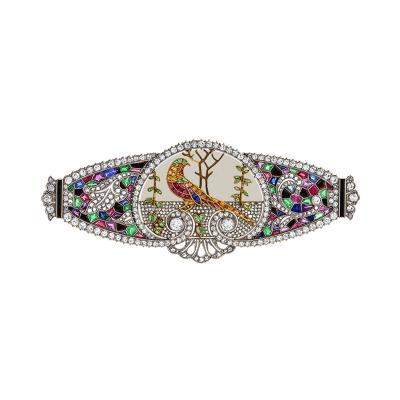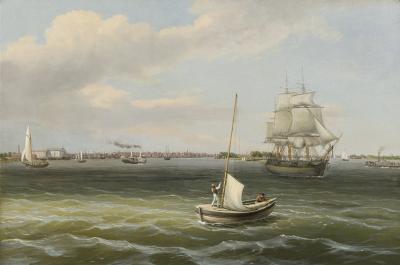Boston and the Boston Art Club, 1855-1950
The Boston Art Club, like the National Academy of Design in New York and the Pennsylvania Academy of the Fine Arts in Philadelphia, provided annual exhibitions that showcased American art. The Art Club placed Boston on the cultural map as early as 1855, with exhibitions of paintings from a circle of talented Boston artists along with New York colleagues John Casilear, Frederic Church, Asher B. Durand, and John Frederick Kensett. In 1873, after a hiatus following the Civil War, the Club began a new exhibition series, now showcasing a vigorous new generation of Boston painters, including many women and accomplished amateur painters. After the building of its new clubhouse in 1882 the Club attracted nationally prominent painters such as William Merritt Chase, Robert Henri, Winslow Homer, Maurice Prendergast and John Singer Sargent. For years the Club’s annuals were the highlight of the season and were featured in Boston and New York periodicals.
The club originated in October of 1854, when Boston painter Frederick D. Williams invited a group of artists and friends to a meeting in his studio. The group resolved to form a club devoted to the appreciation and promotion of fine art. At their first official meeting on New Year’s Day, 1855, they named themselves the Boston Art Club and elected portrait painter Joseph Ames president.1 On the whole, the twenty founders constituted an earnest and serious-minded group of home-spun American artists. Most had started out as self-taught itinerant portrait painters who traveled throughout New England before eventually settling down in Boston. Only six had been to Europe. Several had begun their careers as architectural draughtsmen before switching to painting; a few others worked as illustrators for popular books and magazines. What drew them together, besides friendship, was the need to create adequate exhibition opportunities for themselves; perhaps equally important, they also needed a circle of supportive colleagues from whom they could draw encouragement as they established their careers.
The first order of business was to organize an annual exhibition. They approached the Boston Athenaeum, which had the best gallery in the city and which had been holding exhibitions since 1827. Together the Art Club and the Athenaeum put up a show in 1855. Encouraged by their success, the Club engaged a gallery and club rooms in a house on Bedford Street in 1856.\
Art Club member Alfred Ordway was appointed Director of Exhibitions for the Athenaeum in 1856, and until 1863 acted as the liaison between Athenaeum and the Boston Art Club. He organized annual exhibitions that showcased Boston painters and included works by prominent New York painters.
All was not smooth sailing, however. Club members were keen to educate the public, but the public did not necessarily want to be educated. The Art Club launched an ambitious lecture series in January of 1857 which few people attended and lost them $300 in lecture fees. To raise money they brought in the popular actress Fanny Kemble for a benefit reading of Shakespeare. That evening was a great success. Miss Kemble was appointed honorary member and the bedazzled artists presented her with a portfolio of oil sketches and drawings. Alas, only a few weeks later thirteen paintings were stolen from the Club’s private rooms on Bedford Street. The paintings were never recovered and Club members pledged restitution.
By 1859, Boston was feeling the effects of an economic slump as the nation prepared for war. The outbreak of the Civil War spelled financial disaster for many in the Art Club. Some artists left for brighter prospects in New York or Europe; still others went to the front lines as artist-reporters.The Art Club gave up its rooms on Bedford Street and moved to the newly-built Studio Building on Tremont and Bromfield Streets. After 1863 the exhibitions were discontinued and except for one meeting in 1866, it ceased to be active.
In 1869 a new figure emerged on the scene. The independently wealthy Charles Callahan Perkins (1823-1886) had gone to Europe in 1843 to study painting first in Rome, and then in Paris under academic painter Ary Scheffer. Around this time Perkins began to formulate an ambitious plan to bring artistic culture to Boston. After several extended stays in Europe, Perkins returned to Boston in 1869 ready to make his mark.
He was a classicist and a scholar, and he cherished the idea of Boston as a new Athens. Right after his return he saw an opportunity in the now moribund Art Club. Looking to create a place for people like himself, he saw the importance of uniting benefactors and art lovers in order to encourage general artistic endeavor; what better place than an art club?
Perkins met with an old friend, amateur painter and music publisher George D. Russell, to discuss reviving the Boston Art Club. With Perkins at the helm they called a general meeting, and the suddenly-revived club opened its membership to upper-class men who professed an interest in art (it remained firmly closed to women for the next six decades). The Club engaged a bow-front brick townhouse on Boylston Street for its quarters. In 1871, Perkins, Russell and Horace H. Moses, none of them professional artists, signed the petition to incorporate the Art Club and Perkins was elected President. The Club added a spacious picture gallery behind the building and in 1873 opened its first annual exhibition. From an informal artists’ supper club Perkins created a refined gentlemen’s club with dining and reading rooms, an extensive library, paintings collection and a picture gallery. It hosted two juried exhibitions annually and had a large general membership. The Club also hosted informal gatherings for its members on the first Saturday of each month. Artists would bring in prints or watercolors to critique and a “substantial supper” would be laid out “not without the accompaniment of succulent punches.” One observer happily reported that “artists and their friends make each others’ acquaintance and the hours are spent in chit-chat, good natured criticism and social festivity.”2
The backbone of the Boston Art Club’s public activities was its biannual juried exhibitions, which it hosted until well into the twentieth century. Each show averaged more than 150 works. The first exhibition usually opened in January and the second followed two months later. In 1881, due to the rise in production of watercolors, illustrations and prints, the second exhibition presented only works on paper. Boston artists on the whole had a reputation for being a sanguine and congenial group and there is no doubt the Art Club helped foster this. It provided a meeting place, organization, plus the opportunity to exhibit paintings in large, well-reviewed shows twice a year. Most painters participated in the exhibitions over the years and many joined the Club, contributing a painting in lieu of the membership fee.
Perkins, however, was never able to fully unify local artists. Despite his close personal and professional connections with the charismatic William Morris Hunt, by 1874 Hunt had largely withdrawn from clubactivities, taking many of his followers with him. This provoked the consternation of critics, many of whom felt that Hunt and his circle constituted the most promising group of artists then working in Boston. Further divisions occurred within the club itself. Because the number of businessmen members far outnumbered the artists (by 1875 the ratio was about 5 to l), it was inevitable that disputes would arise. The most pointed disagreements centered on the hanging committees. Responsible for laying out the paintings along the gallery walls, they constantly came under fire from critics and disgruntled artists for placing poor paintings in prime spots, and good paintings in poor spots. The artists had little control over the jury or hanging committees, both of which were dominated by non-artists whom they felt to be woefully undereducated in matters pertaining to art. The Club took steps to alleviate the situation but conflicts continued.
Matters came to a head in 1880, when it became clear that the Club needed new quarters. Although the road had been somewhat bumpy, Perkins had guided the art club through ten years of growth and activity. Membership had grown from a few “hopeful souls,” as Perkins referred to them in 1869, to nearly six hundred by 1880.
The club had hosted sixteen juried exhibitions and countless smaller shows. Perkins had successfully coaxed his members to put aside their differences, and the club’s monthly dinners were widely reported to be amiable and enjoyable occasions. In 1880, anticipating the termination of its lease on the Boylston quarters, the club decided to build a permanent clubhouse. This was a decisive turning point for the club, toward greater institutionalization and the consolidation of power in the hands of those who could afford the expense of the building. Having led them to that point, Perkins decided it was time to step aside. At the January 1881 annual meeting he announced his retirement as President of the Art Club.
During the last two decades of the nineteenth century, Boston’s art world expanded and developed into the golden age that Perkins had envisioned so many years before. The fortunes of the Boston Art Club rose with the tide. By 1884 there were nearly nine hundred members, eight hundred of them non artists. The governors of the club took steps to improve the quality of the annual exhibitions and give Boston painters more prominence. A new generation of young Paris-trained painters began to exhibit there, such as Frank W. Benson, Edward Tarbell and Joseph deCamp, bringing with them a fresh vigor and the first taste of impressionism. In 1886 the Art Club mounted a one-artist show of paintings by New York painter William Merritt Chase to enthusiastic reviews.
Boston Art Club, the grandam art club of both New York and Boston, saw itself as a permanent fixture in the cultural universe in its newly-built stately clubhouse. However, it was inevitable, given the tenor of the times and the displacement of artists within the Art Club’s ranks, that the artists themselves began to form smaller associations. The Boston Art Students’ Association (in 1901 renamed the Copley Society) and the Paint and Clay Club established themselves in 1879.
The following year saw the formation of the St. Botolph Club, the Draughtsmen and Artists’ Association, the Roxbury Crayon Club, the Boston Crayon Club and the Society of Decorative Art. Quickly on their heels came the Etching Club (1881), the Tavern Club (1884), the Water Color Society (later renamed the Boston Society of Water Color Painters) (1885), and the Boston Water Color Club (1887). The clubs were not mutually exclusive; typically artists joined more than one. Because the Boston Art Club had one of the city’s best gallery spaces it was frequently used by the Boston Art Students’ Association, the Paint and Clay Club and the watercolor clubs for their members’ exhibitions.
The St. Botolph Club emerged as the Art Club’s strongest competitor. Patterned after the Century Club in New York, the St. Botolph Club established itself as representing the cream of Boston society, letters and art. It siphoned off from the Art Club some of its prominent members and many of its best pictures for its own annual exhibitions. Interestingly enough, one of its founding members was Charles Callahan Perkins, who perhaps had never lost sight of his original objective to unite artists with patrons in an enlightened intellectual environment. Its kick-off exhibition, opening in May of 1880, was called “the most brilliant collection of paintings ever gathered here…”3
The booming art culture that had elevated the Boston Art Club’s profile ultimately moved beyond it; by about 1900 the heyday of the Art Club had passed. It continued to host exhibitions but the shows were no longer considered the big event of the season. There was stiff competition nationally and locally. The Club retrenched. In 1910 its leadership, which had consisted of businessmen since Perkins’ departure, decided to renovate the entire building, putting in new dining rooms and bedrooms and dividing the picture gallery into smaller exhibition spaces. The monthly dinners continued but the large juried exhibitions became increasingly sporadic in favor of smaller members’ shows and one-artist exhibitions. The main intent of the club now was to accommodate the comforts of its gentlemen members.
The final chapter of the Art Club contains some surprises. In 1912 artist Charles Hovey Pepper went to lunch at the Boston Art Club and was so pleased by it that he immediately joined. As a young man Pepper had studied painting in New York and Paris. In 1903 he embarked on a tour around the world, spending several months in Japan and traveling through southeast Asia, India, and the Middle East before returning to Boston in 1904. Now at mid-career, Pepper had established himself as a modernist, following the lead of the progressive painters such as Marsden Hartley and Arthur Dove. Pepper recognized the Art Club’s potential. By this time, artists no longer depended upon the Art Club as their major source of exposure in Boston. The Club, as conservative as it had always been, now lay fallow, a perfect setting for Pepper and his circle of moderns. Its galleries, now smaller than they had been in the nineteenth century, were especially suitable for the watercolors which were favored by many modernist painters.
In 1917 Pepper became Director of the Exhibitions Committee, and he put his friends Charles Hopkinson and Harley Perkins on the committee. Together they proceeded to exhibit the work by traditional painters shoulder to shoulder with paintings by more modern artists. In the fall of 1918 Pepper initiated the New England Artists’ Series, an annual exhibition of young, little-known but talented artists. Pepper’s efforts were applauded by some of Boston’s most important critics. The general public thought otherwise. One person growled: “It is the rottenest show I ever saw in Boston.”4 Pepper and his group persevered. In 1926 the Boston Art Club became the springboard for the New Society of Watercolor Painters, formed by Pepper and five other modernists who had broken away from the conservative Boston Society of Water Color Painters: Marion Monks Chase, Charles Gordon Cutler, John Goss, Charles Hopkinson, and Harley Perkins. In 1926 Edward Hopper, Charles Demuth and Ernest Fiene exhibited with them in what an admirer called “one of the most distinguished watercolor shows ever presented by the Art Club.”5
It couldn’t last. In 1928 the Art Club fired the entire Exhibitions Committee. The embroglio involved even the Governor of Massachusetts, Alvan T. Fuller, who was a member of the Art Club and who placed himself on the new Exhibition Committee. Hermann Dudley Murphy, who also joined the new committee, explained, “For the past five or six years we have had an exploitation of modernist art at the club. You know what I mean, that crazy stuff…We believe the people are rather tired of this sort of thing.”6
The club continued to function for the next two decades, albeit with little fanfare. The day of the big annual exhibition had passed; the art world was fragmenting. In 1933 the club decided to admit women as members, but still only through the public entrance and only in specified club rooms. Boston’s prominent female painters were cool to the idea: “I don’t know that I will join. I’ll have to think it over,” said Marion Waitt Sloane. “I don’t know why women shouldn’t join the Boston Art Club, but I doubt if I will join it. I am already a member of many organizations…” added Marie Danforth Page.7 In 1941 the club joined forces with the Grace Horne Gallery. Grace Horne took over the first two floors and gallery space while club members retreated to the top floor.
Finally in 1950 the Art Club was dissolved. The library and collections were dispersed and sold to the club’s remaining members; the building was sold at public auction, thus bringing to a close nearly a century of artistic activity. For the next several decades its history lay forgotten. But the accomplishments of the club should not be underestimated. In its heyday it contributed to the professionalization of Boston artists by giving them regular exposure in their prominent exhibitions. It also garnered for Boston itself prestige and status as a cultivated city that could support a broad-based vigorous art culture, an accomplishment that no doubt would have astonished many of the original twenty founders as they sat in Frederick Williams’ studio so many years ago.
Nancy Allyn Jarzombek is Director of Exhibitions at Vose Galleries of Boston. She has written extensively on nineteenth century Boston arts and culture. This article is a condensed version of one that appears in the exhibition catalogue, “A Taste for High Art, Boston and the Boston Art Club, 1855-1950.”
The exhibition will be at Vose Galleries of Boston from October 12 to December 31, 2000.
All illustrations courtesy of Vose Galleries, 238 Newbury Street, Boston, MA 02116 or tel. (617) 536 6176.
2 “The Boston Art Club,” Art Journal n.s. 3 (March 1875): 95.
3 Greta, “Boston Correspondence,” The Art Amateur 3, no. 1 (June 1889): 6.
4 F. W. Coburn, “In the World of Art,” Sunday Herald (December 5, 1920): sect. C, p. 6.
5 “A Dynamic Show. Watercolors by Nine Exhibitors Provide a Handsome and Distinguished Exhibition at the Art Club,” Boston Evening Transcript (October 16, 1926): book sect., p. 8.
6 “Ousts Modernists as Art Committee,” New York Times (September 8, 1928): 8.
7 “Women Coy of Art Club Move to Woo Them,” unidentified newspaper clipping, 1933. Gertrude Fiske papers, Vose Galleries of Boston, Artists’ Files.



















.jpg)

















